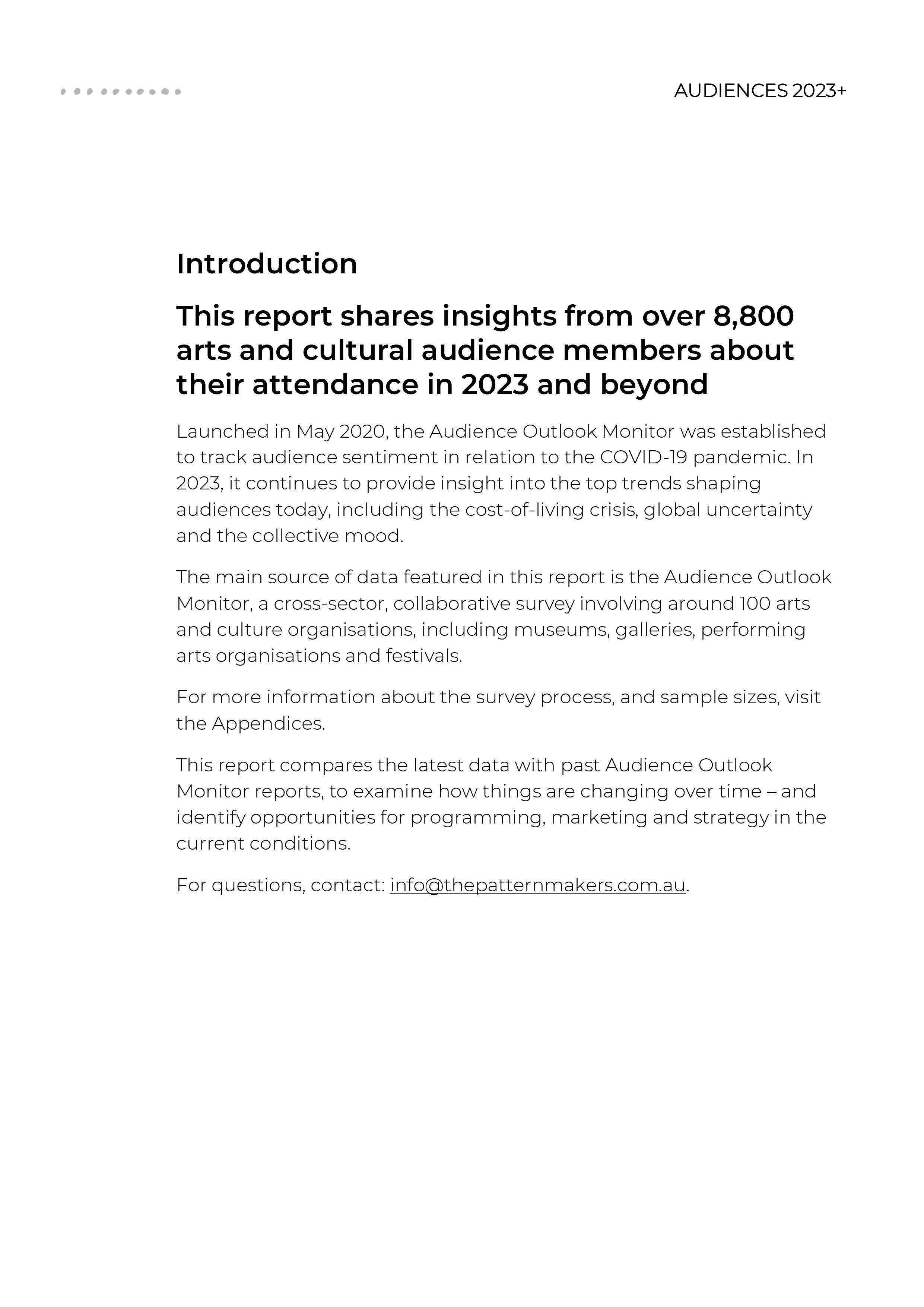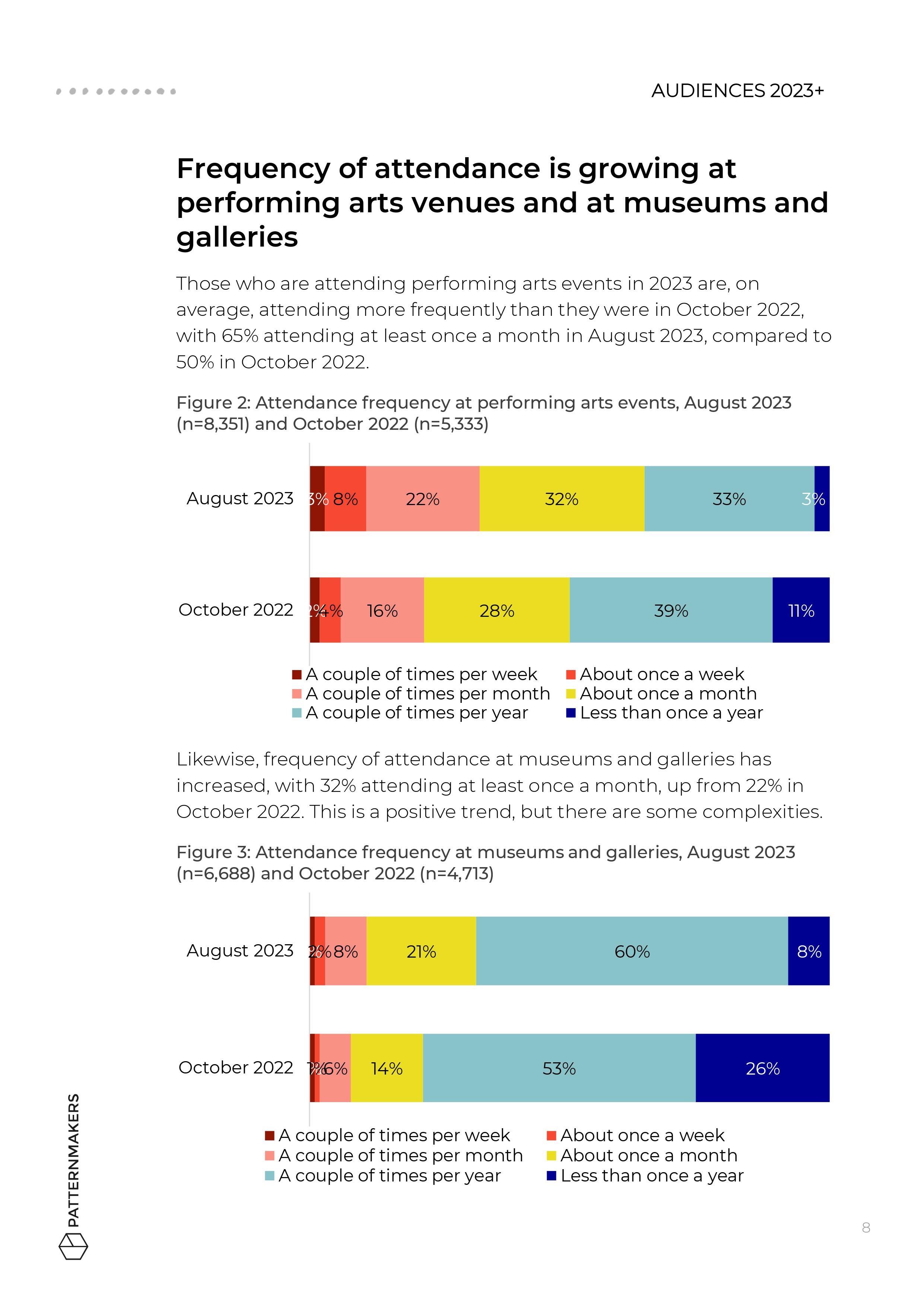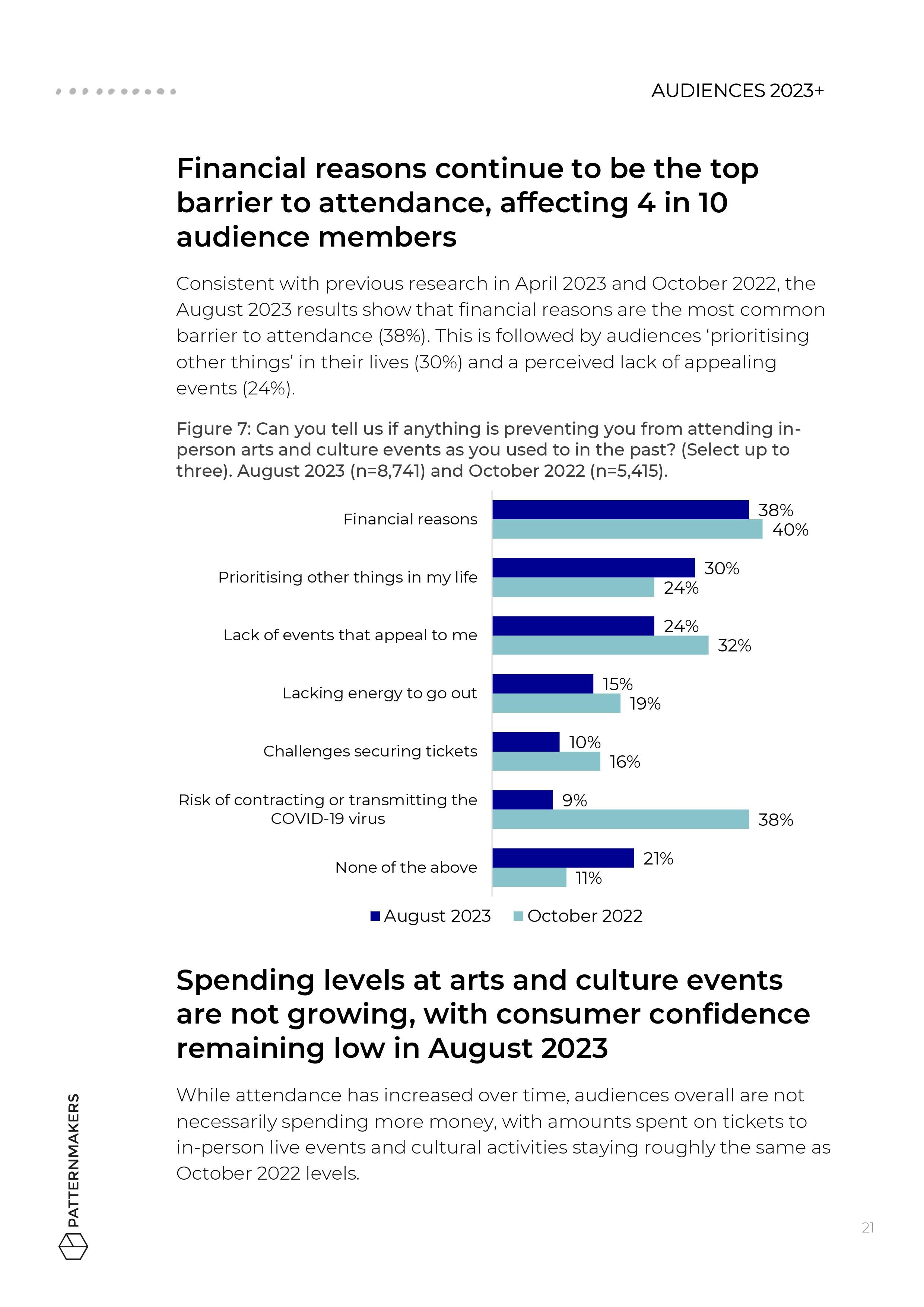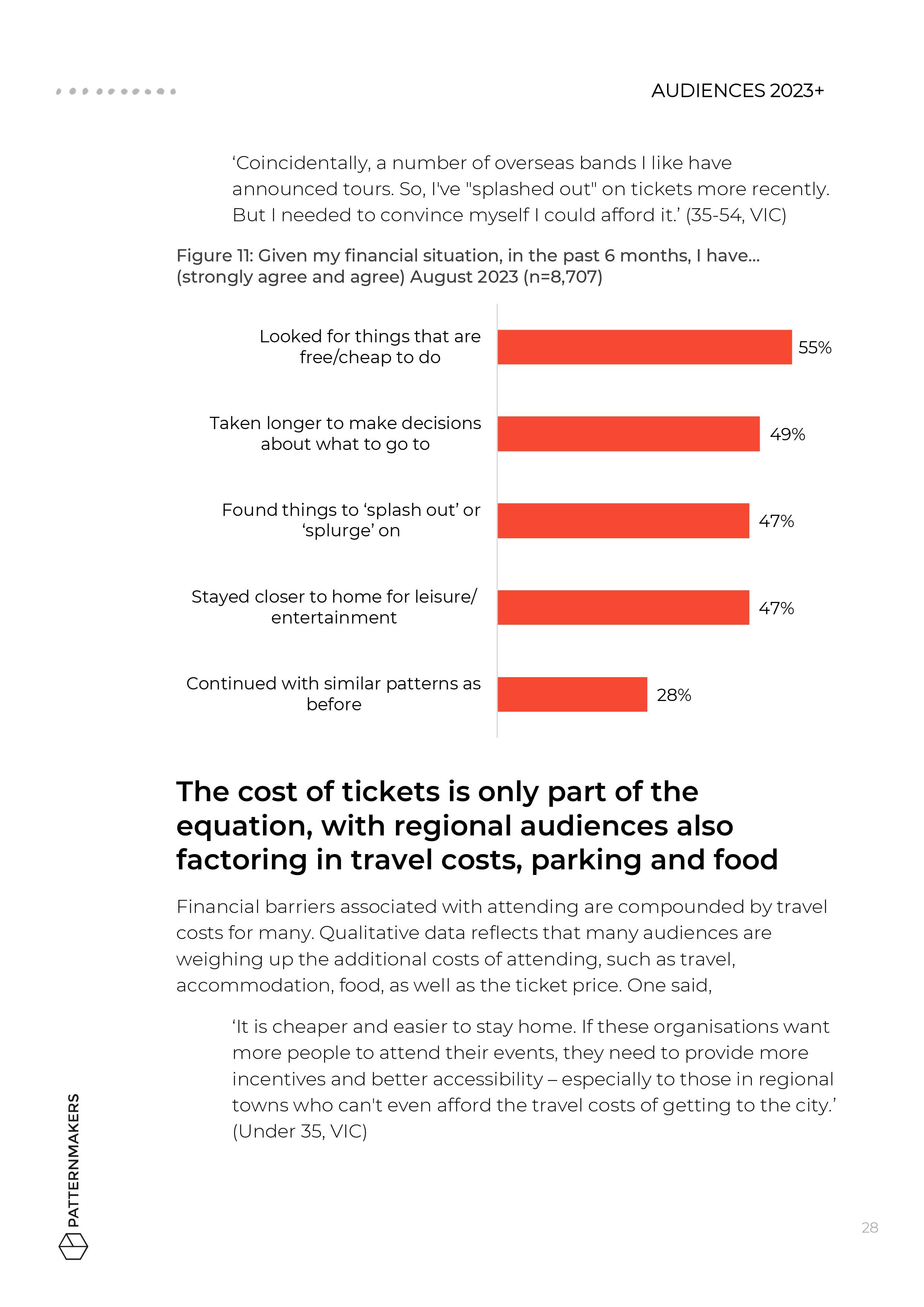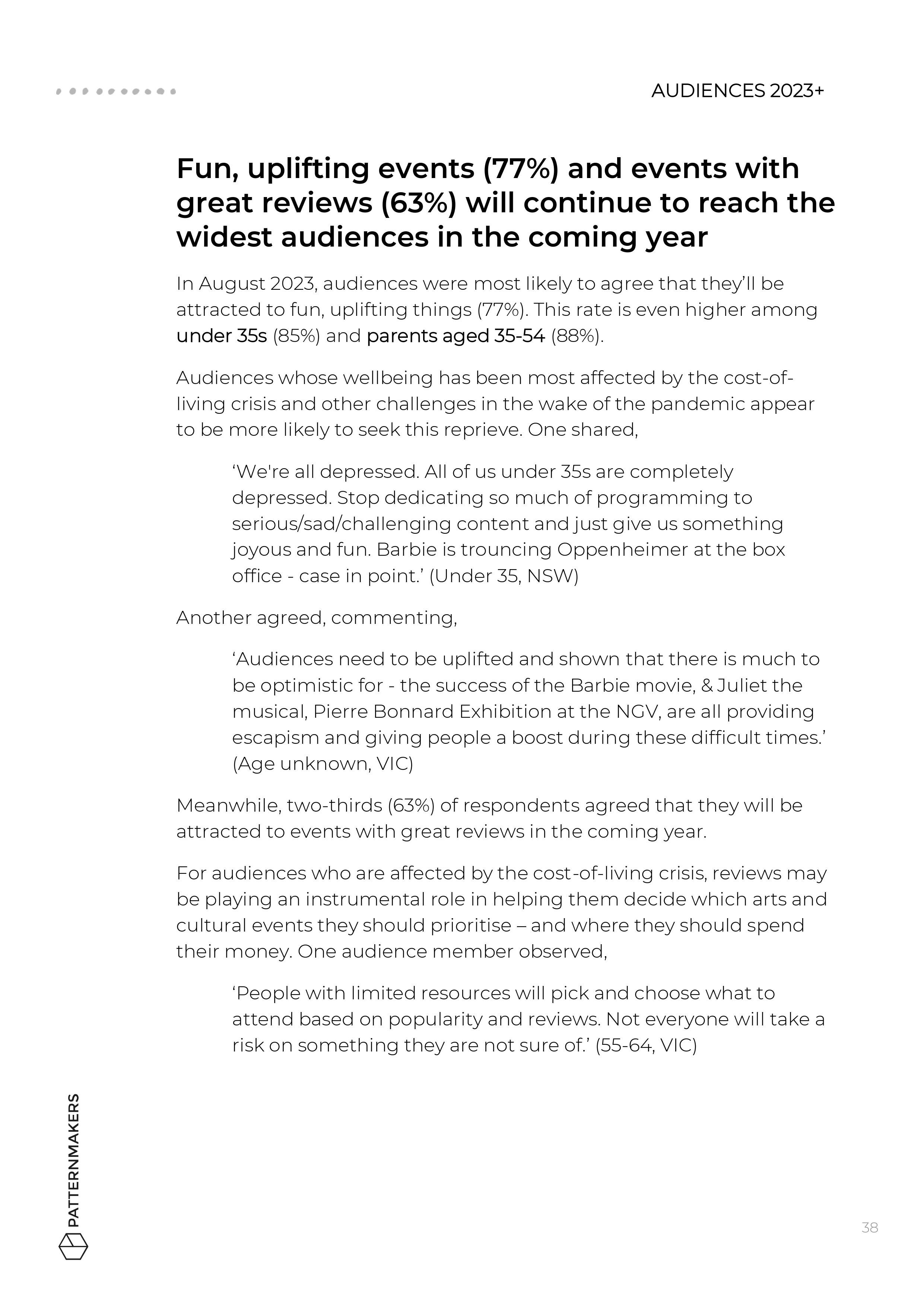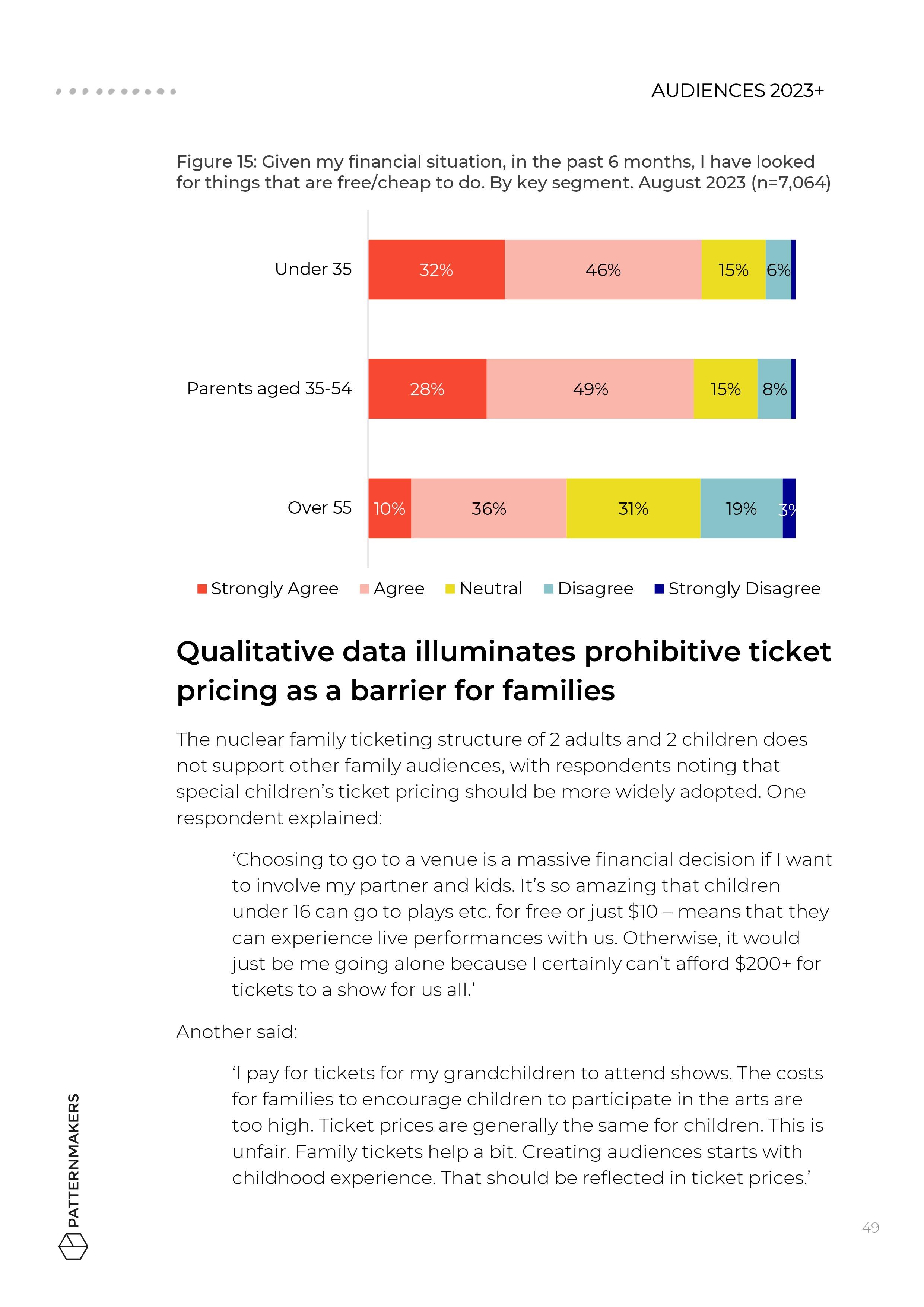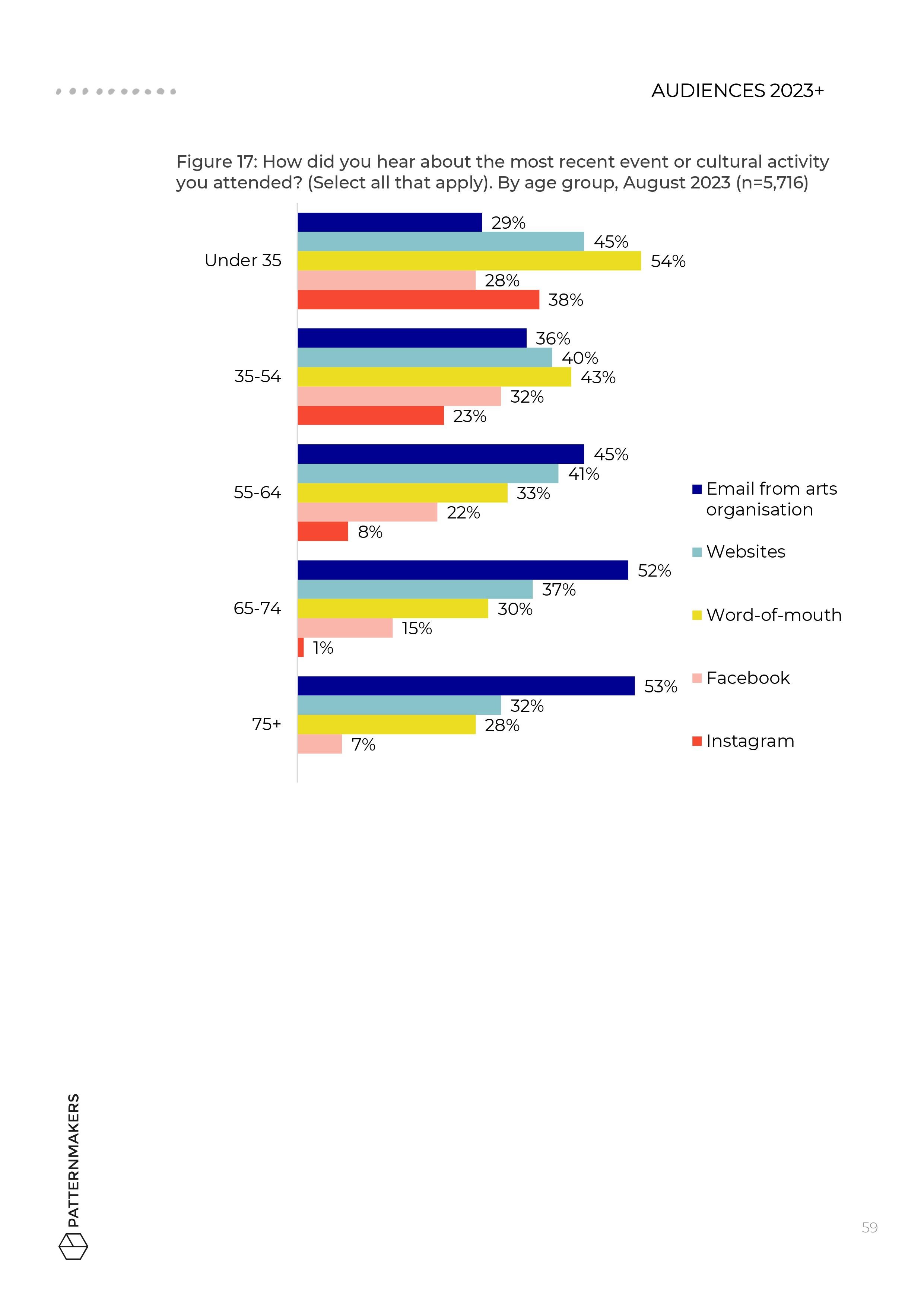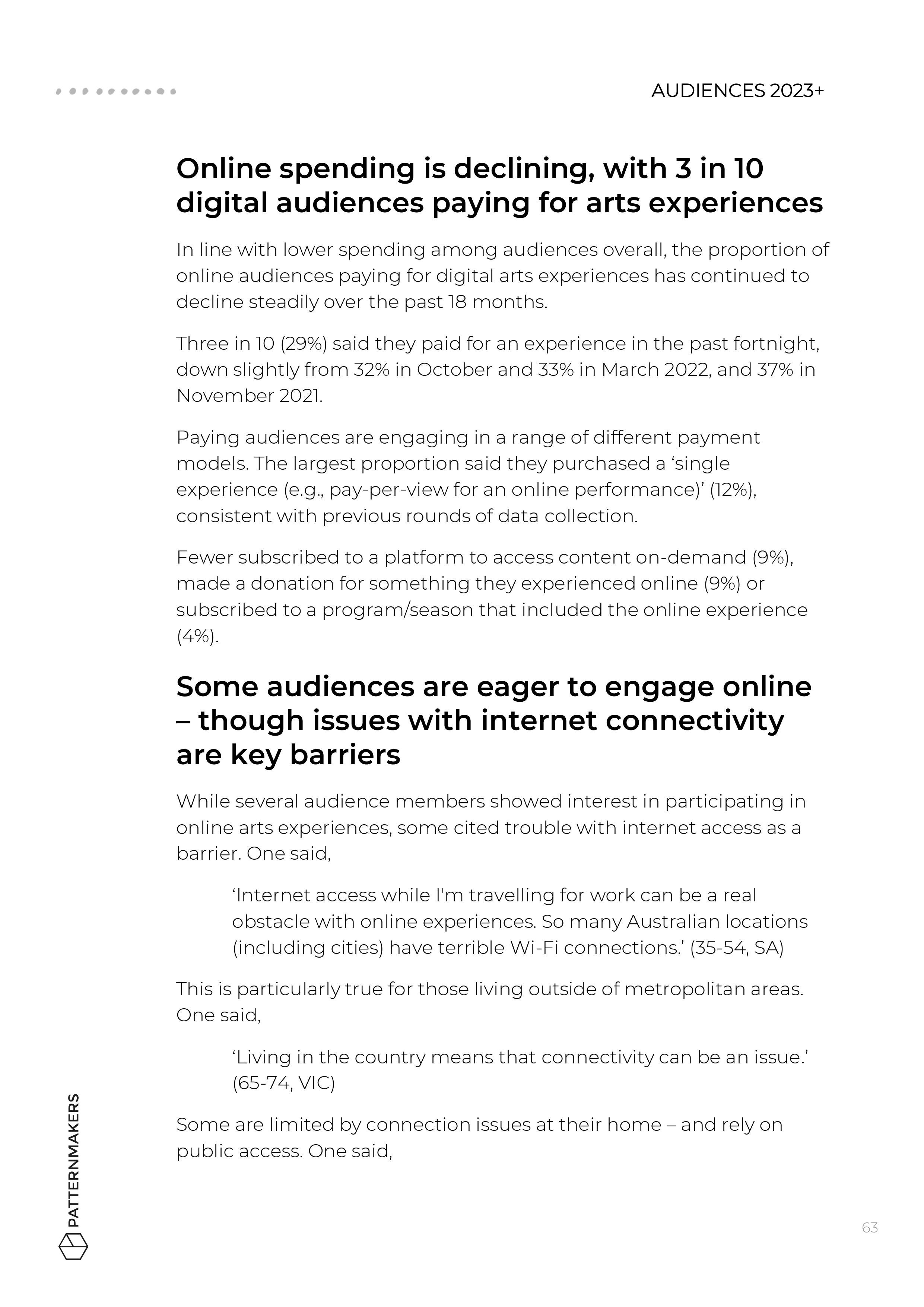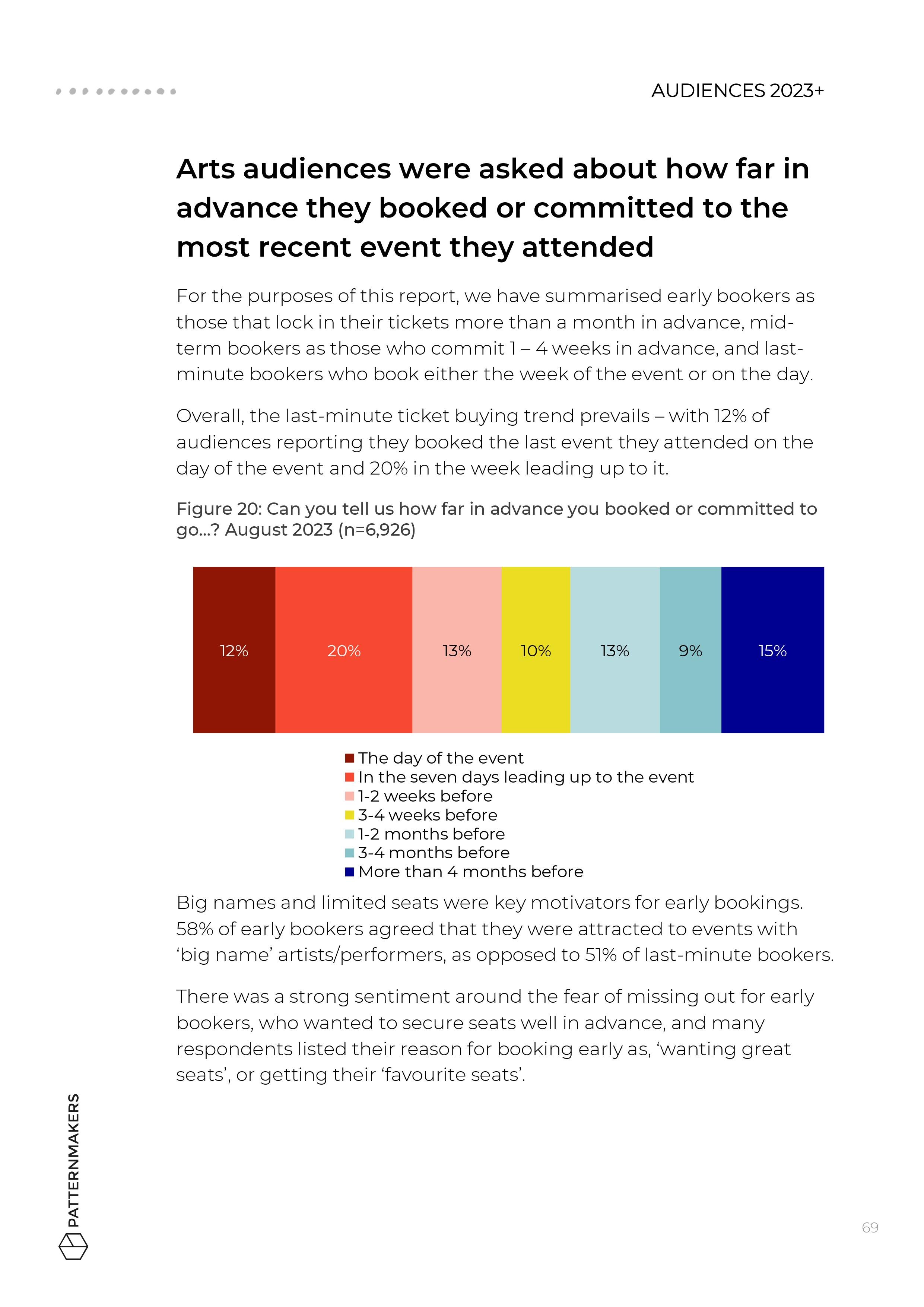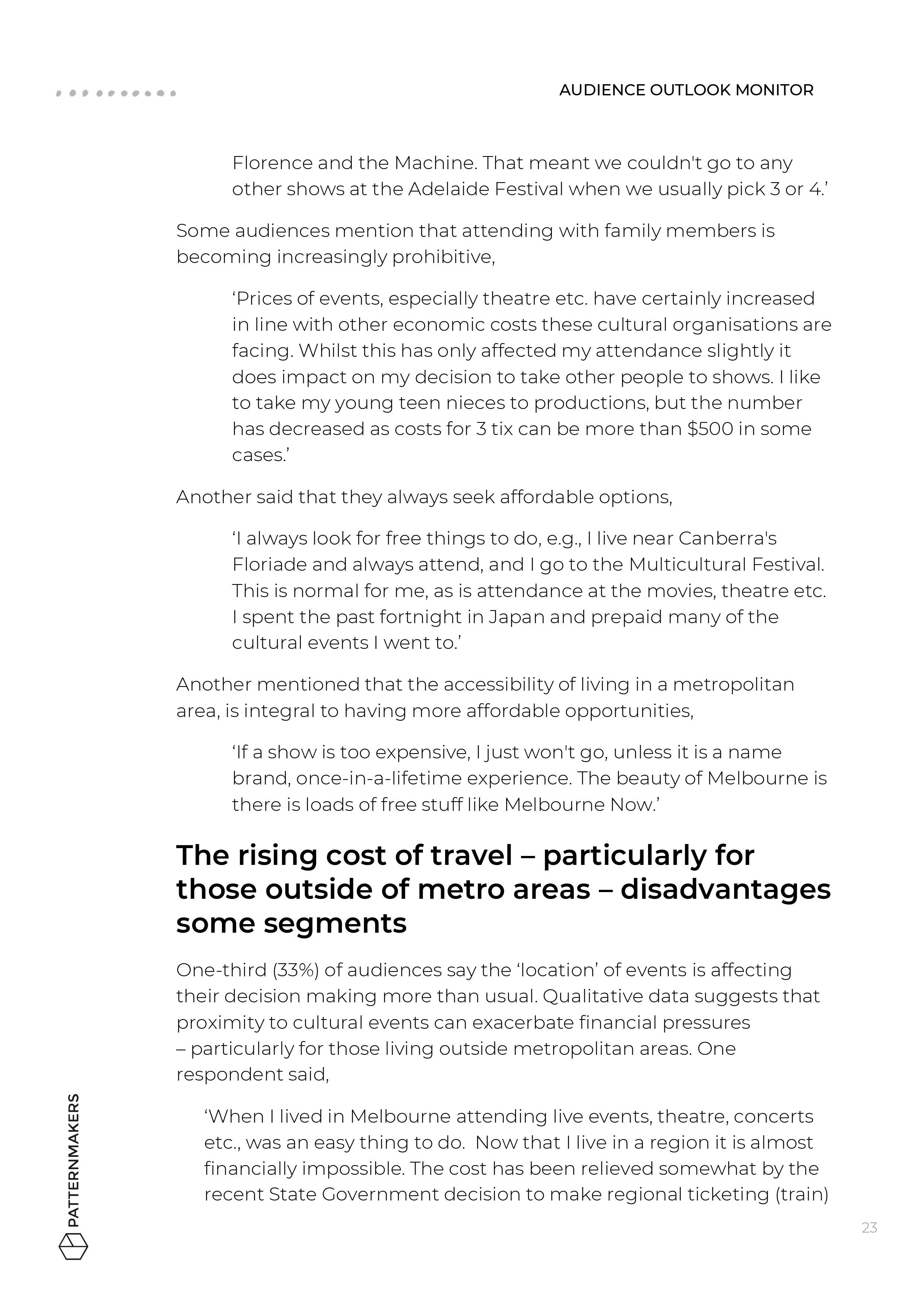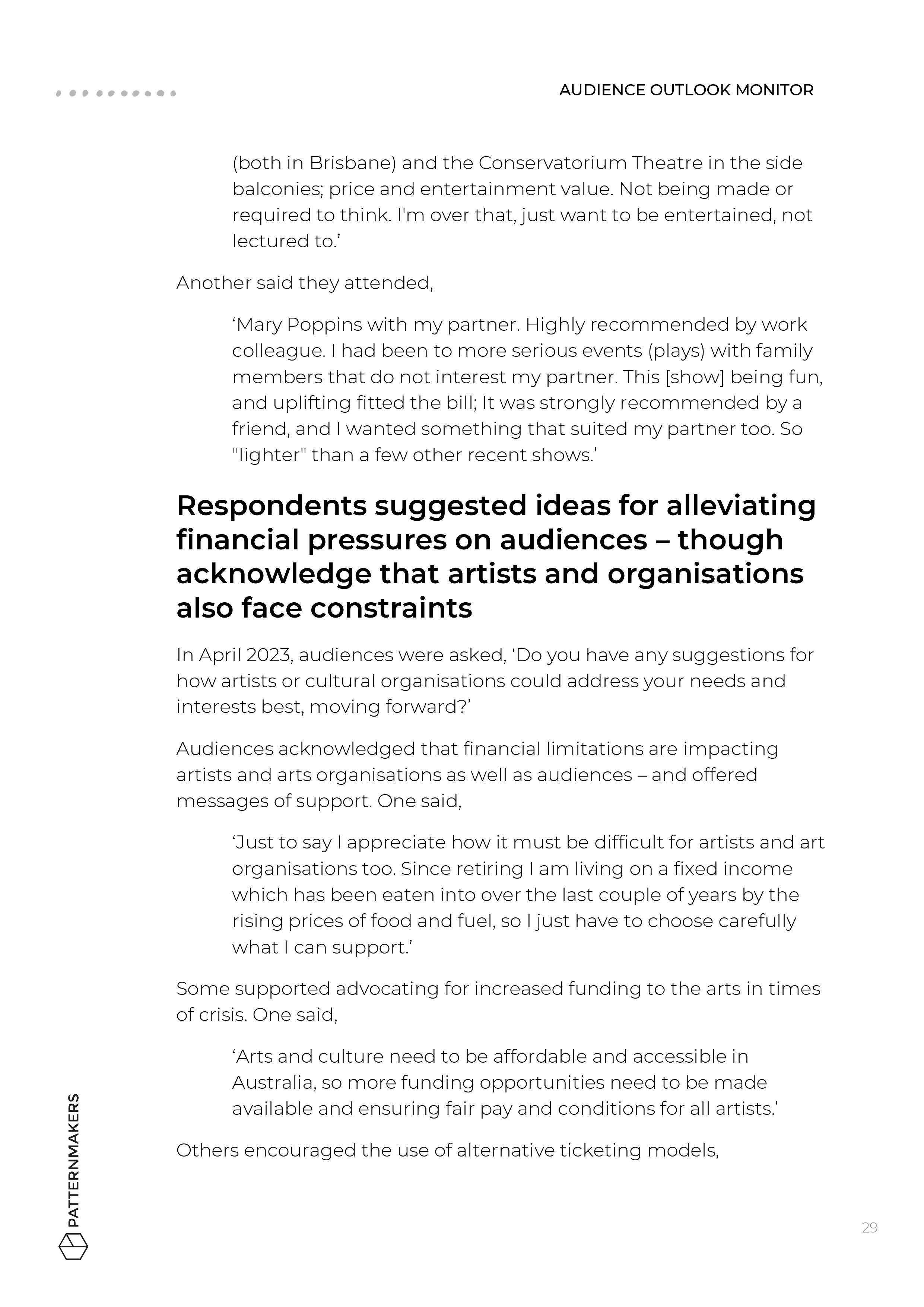When Art Sparks Change
In 2024, Creative Australia commissioned us to collate a selection of local CACD case studies to share their stories and showcase the inspiring work led by CACD artists. Explore the digital resource to learn more.
All around Australia, artists are sparking social change, working with communities to tell their stories, tackle big issues and create common ground.
You're probably familiar with Community Arts and Cultural Development (CACD), a specialist art form, where professional artist facilitators work with communities to co-create projects with purpose. However, many Australians are not. Research shows that of all the artforms, our population has a particularly limited understanding of the benefits of CACD.
This new resource launching today collates a selection of local case studies to showcase the inspiring work led by CACD artists. As Australia grapples with a civic crisis, their work has never been more needed.
Click the button below and scroll through the digital resource: 'When Art Sparks Change' or download the PDF detailing the web content.
Image: Georges Riverkeeper, STARTTS & Jiva Parthipan’s The River Project
Head to the resource to see why we think CACD projects deserve a bigger profile, and dive into:
How Milk Crate Theatre used devised theatre to facilitate social inclusion for people at risk of, or experiencing, homelessness
How All The Queens Men curated a lavish party to facilitate pride, celebration and visibility for LGBTIQ+ elders
How Carclew addressed isolation amongst youth in regional South Australia through facilitating the opportunity for emerging young writers to develop their own monologues
How Jiva Parthipan and the NSW Service for the Treatment and Rehabilitation of Torture and Trauma Survivors (STARTTS) engaged with place-making and cross-cultural understanding through a creative experience along the Georges River in Casula NSW
Spoiler: the impacts are profound.
If you’re a CACD practitioner, artist or arts organisation looking to create your own case studies, check out our template for some recommendations on format and flow.
If you have any thoughts or questions about this resource, or about how digital storytelling can spread the message about good causes, get in touch with us via info@thepatternmakers.com.au
Image: Robert Catto, Milk Crate Theatre’s DUST.
Acknowledgements
This resource is dedicated to CACD practitioners everywhere, working to address disadvantage and bring Australians together.
It has been created by research agency Patternmakers, with assistance from the Australian Government through Creative Australia, its principal arts investment and advisory body.
Thank you to the practitioners who participated in the creation of this resource and to the many partners involved in each of the projects profiled.
Authors
Peta Petrakis, Senior Research Analyst
Melanie Raveendran, Digital Marketing Coordinator
Tandi Palmer Williams, Managing Director
Categories
Archive
- 2023 21
- Dance 3
- Research 99
- Audience development 79
- Arts 73
- COVID-19 70
- Culture 72
- Data culture 69
- Evaluation 75
- Innovation 78
- Thought leadership 16
- About Patternmakers 35
- Privacy 6
- Project updates 25
- Culture Panel 1
- Resources 6
- Toolkit 5
- Beyond the Bio 8
- 2022 23
- Career Advice 9
- Opportunities 4
- Tips & Tricks 13
- 2021 7
- 2024 1
- First Nations 3
- Indigenous 2
- Strategic Planning 5
- Trends 3
- Performing Arts 5
- Manifesto 1
- Education 2
- Capacity building 3
- Digital art 4
- Interviews 3
- Coronavirus 2
- 2020 3
- Tandi Palmer Williams 7
- Theory of Creativity Podcast 1
- 2019 11
- Top 5 2
- 2018 12
- Case Studies 2
- Our services 4
- Postcode Analysis 1
- Accessibility 4
- Touring 3
- Publications 1
- 2017 8
- Data art 2
- 2016 5
Be in the loop
From stadium gigs to screen-time: Looking back at the top audience moments of 2023
In this article, we cast our mind back to the sell-out stadiums, packed movie theatres, and record-breaking festivals of 2023, to bring you the biggest moments shared by Australian audiences.
We cast our mind back to the sell-out stadiums, packed movie theatres, and record-breaking festivals of 2023, to bring you the biggest moments shared by Australian audiences.
As 2023 was nearing its close, our team got chatting about the top audience moments of the year — and what we learned along the way.
It seems obvious but it’s actually pretty special: many of us have loved being in crowds again. After the awkwardness and isolation of the pandemic, 2023 was about having that collective experience: the feeling of being 100% in the moment alongside thousands of other people.
In this article, we take a look back at a year marked by sell-out stadium performances, shock cancellations, packed movie theatres, and record-breaking festivals.
The Matildas didn’t win the World Cup but, instead, changed women’s sport for good
The Matildas drew in record-breaking viewership for their incredible run at the Women’s World Cup - capturing the hearts of audiences around the globe but especially here at home.
Our team has some insight into the complex funding decisions behind major events (hint: they ain’t cheap), but this one set a new precedent for the enormous intangible value that results from hosting global events like the World Cup.
Cost-benefit ratios aside, the iconic semi-finals shootout cemented Sam Kerr’s legendary status, and the Matildas keen following saw the team become Australia’s most valuable brand in sports. The start of a new chapter, not just for women in sport, but for Australian society, period.
Barbenheimer brought us back to the cinema, on the double!
Perhaps the biggest comeback in 2023 saw audiences returning to the big screen in swathes, driven by Barbie and Oppenheimer’s competing release dates (as well as an unprecedented marketing effort and press tour by Warner Bros.).
Like other kinds of cultural events, cinema attendances took a big hit during the pandemic, but things began looking a lot rosier as these two films approached our shores.
Fuelled by the viral ‘Barbenheimer’ meme, a new phenomenon emerged, leading audiences across the globe to purchase tickets to both films as a double feature. This unlikely combo showed that, when done right, audiences are up for both uplifting and challenging stories.
We loved seeing people dressing up again for a new release (who doesn’t love an excuse to wear head-to-toe pink?) and sharing their experience on socials. It was also interesting to see movie-goers purchasing tickets pre-release. Some research showed that 43% of Barbie audiences were infrequent moviegoers, meaning they hadn’t been to the movies in the last 6 months.
Blockbuster stadium tours showed us how to make friends with strangers
After a patchy 2022, demand for concert tickets was back in full force, with international acts taking centre stage (and emptying wallets everywhere).
There are signs this hasn’t been good news for everyone – with indie gigs hurting at box offices across the country – and continuing the tough times for many small and medium companies.
Most newsworthy was the internet-breaking presales for Taylor Swift’s 2024 ERAS Tour (some of our team were lucky to snap up tickets).
Beyoncé’s Renaissance World Tour was her highest-grossing tour yet, and Swift’s revenue surpassed the billion-dollar mark.
Putting the market distortion aside, we’ve been amazed by the stadium experiences these acts are putting on for the crowds – and how adorable is the friendship bracelet trend? Swifties are bringing new levels of sweet to concerts, and heralding in a new era of connection through shared experiences.
Disability activism inspired new levels of access at events
It’s been a long time coming but in 2023, it was great to see some incredible examples of accessibility at events.
We’ve watched as events outdid each other with new access and inclusion initiatives, welcoming broader audiences than ever before.
Our friend Morwenna Collett reported back from Ability Fest: ‘There were Auslan interpreters on both stages all day (including the incredible Mikey Webb), captioning on the Main Stage, Bindi Maps for site navigation, a nicely kitted out sensory room, a chill out space, two accessible viewing platforms, ample first aid, a well-being tent, a service animal toileting area, accessible buggies to move people between the two stage areas, loads of helpful volunteers, a fab access liaison contact officer with lived experience, good signage, loads of track matting, shaded areas, strobe warnings, an awesome disabled photographer documenting the event and of course multiple disabled musicians on the bill.’ Wow.
We’re seeing more and more great initiatives popping up, like Auslan Santa at Westfield – and amazing acts by disabled artists at festivals around the country.
In January, our team launched a new research report – showing that its not just disabled and immunocompromised audiences who benefit from these changes, but the friends, families, support workers and groups that accompany them, so hear hear!
A big thank you to all the tireless advocates who have championed change for a long time.
Festivals brought the fun (and crowds) back into cities
We’re still talking about Adelaide Fringe’s huge achievement in selling 1 million tickets for their 2023 festival and topping their pre-COVID ticket sales from 2019. In possibly the biggest ticketing comeback of 2023, Adelaide Fringe was able to swing a miracle through strategic coordination across updated databases, a healthy mix of free and cheap offerings, an optimised box office experience and a sponsor-backed ticket flash sale.
Sydney WorldPride 2023 drew over 1 million audience members to the festival (double what was expected), with around 70,000 people coming to NSW especially to attend. It was the first time WorldPride, the largest LGBTQIA+ festival in the world, was hosted in the Southern Hemisphere. This history-making event was the biggest in Sydney since the 2000 Olympics!
It’s not all roses in festival world, with Dark Mofo breaking news as they announced a fallow year in 2024. They say absence makes the heart grow fonder so we’ll be watching with interest to see what audiences do when it returns to Hobart in 2025.
Major institutions turned up the volume on free events
In August, our major report Audiences 2023+ showed that cost is now the top barrier limiting people’s attendance at cultural events. Luckily, the arts sector is responding with an amazing array of free events.
The beloved Sydney Opera House celebrated it’s 50th birthday in 2023, and hosted a month-long Birthday Festival in October where audiences were treated to a broad range of ticketed and free events from theatre to contemporary music and lectures. They produced ‘Play It Safe’, a 50th Anniversary film showcasing dance, music and theatre, and shared 50 iconic Sydney Opera House film recordings for free over 3 months to celebrate 5 iconic decades.
The history-making Melbourne Now returned for the first time since 2013 at The Ian Potter Centre: NGV Australia. The exhibition took over NGV’s Fed Square gallery and included more than 200 Victorian practitioners across disciplines. The exhibition and programming saw audience attendance records break, with success factors from the unique mix of local creatives on show as well as the breadth of public programming – all enjoyed for free!
Thank you to all of the amazing artists, event organisers and cultural venues that worked so hard to make 2023 such a special year for audiences.
May the good times roll in 2024!
Categories
Archive
- 2023 21
- Dance 3
- Research 99
- Audience development 79
- Arts 73
- COVID-19 70
- Culture 72
- Data culture 69
- Evaluation 75
- Innovation 78
- Thought leadership 16
- About Patternmakers 35
- Privacy 6
- Project updates 25
- Culture Panel 1
- Resources 6
- Toolkit 5
- Beyond the Bio 8
- 2022 23
- Career Advice 9
- Opportunities 4
- Tips & Tricks 13
- 2021 7
- 2024 1
- First Nations 3
- Indigenous 2
- Strategic Planning 5
- Trends 3
- Performing Arts 5
- Manifesto 1
- Education 2
- Capacity building 3
- Digital art 4
- Interviews 3
- Coronavirus 2
- 2020 3
- Tandi Palmer Williams 7
- Theory of Creativity Podcast 1
- 2019 11
- Top 5 2
- 2018 12
- Case Studies 2
- Our services 4
- Postcode Analysis 1
- Accessibility 4
- Touring 3
- Publications 1
- 2017 8
- Data art 2
- 2016 5
Be in the loop
Dance Sector Uplift
In 2023, Arts Northern Rivers commissioned Patternmakers to assist with the Dance Sector Uplift project, designed to reactivate dance, physical theatre and experimental performance across the region. Download the report and watch the webinar to hear us unpack the findings.
In 2023, Arts Northern Rivers commissioned Patternmakers to assist with the Dance Sector Uplift project, designed to reactivate dance, physical theatre and experimental performance across the region.
This partnership stretches back to the Creative Industries Recovery Forum in 2022, which we attended and developed a report to identify sector priorities in order for the creative industries to flourish again after the severe storms and flooding hit communities across Northern NSW and Southern QLD.
Arts Northern Rivers undertook three streams of focus to support the region’s activation, recovery and renewal, identified as Public Art, First Nations Arts, and Dance/Physical Theatre.
In consultation with local artists, Arts Northern Rivers was committed to stimulating the region with a revitalisation of the dance sector by supporting activities which nourish and promote the region as a creative, thriving and growing centre of diverse embodied practice.
Local dance maker and producer, Philip Channells managed the delivery of the project. Philip works across art forms including dance/theatre, film, performance installation, community art projects, site-specific work and artist residencies with collaborators who value, challenge, redefine and inform our different perspectives of contemporary life.
“Approaching the Dance Sector Uplift (DSU) research project through a broad lens of diversity and inclusion enabled conversations amongst the sector, acknowledging the diverse cultural influences, creative practices and lived experiences of practising artists.
This conversational approach led us to realise the need for various stages of research to ensure a broad set of important voices were caught in the process.”
This project was informed by a multiplicity of consultation methodologies with members of the Northern Rivers performing arts sector, including local Bundjalung, Yaegl and Gumbaynggirr leaders, knowledge keepers of dance, dance makers and performers and global Indigenous and CALD artists living in the region.
Arts Northern Rivers conducted a survey inviting all artists working across an embodied practice to contribute to the research and design process for the reactivation of dance.
We analysed and compiled the results of these surveys and consultations into a full report in order to inform the direction and outcomes of the project. The report identifies the strengths and challenges, supported with evidence and data, and recommendations on how to plan ahead, to create a vision, and help independent artists realise their creative potential while working collectively within the community.
Download the Dance Sector Uplift report below for the full story.
Click below to watch the webinar where the findings from the report were delivered to all the participants from the local dance sector.
Image | Dancers: Omer Backley-Astrachan, Kirsty Kiloh, Charemaine Seet in The Draw IN by Geraldine Balcazar. Photograph by Shane Rozario.
Categories
Archive
- 2023 21
- Dance 3
- Research 99
- Audience development 79
- Arts 73
- COVID-19 70
- Culture 72
- Data culture 69
- Evaluation 75
- Innovation 78
- Thought leadership 16
- About Patternmakers 35
- Privacy 6
- Project updates 25
- Culture Panel 1
- Resources 6
- Toolkit 5
- Beyond the Bio 8
- 2022 23
- Career Advice 9
- Opportunities 4
- Tips & Tricks 13
- 2021 7
- 2024 1
- First Nations 3
- Indigenous 2
- Strategic Planning 5
- Trends 3
- Performing Arts 5
- Manifesto 1
- Education 2
- Capacity building 3
- Digital art 4
- Interviews 3
- Coronavirus 2
- 2020 3
- Tandi Palmer Williams 7
- Theory of Creativity Podcast 1
- 2019 11
- Top 5 2
- 2018 12
- Case Studies 2
- Our services 4
- Postcode Analysis 1
- Accessibility 4
- Touring 3
- Publications 1
- 2017 8
- Data art 2
- 2016 5
Be in the loop
City lights to red dirt: Connecting with audiences across Australia
In this Audience Outlook Monitor report, ‘City Lights to Red Dirt’, we look at the geographic trends in data collected from past attendees to cultural events, comparing audiences in big cities, outer suburbs and the regions.
Our cities, suburbs and regions are different places today and audiences are responding in interesting ways.
Attendees of arts and cultural events are feeling the pressure of the housing crisis, changing work and commuting patterns, navigating weather events and approaching travel and leisure differently.
In this new report, ‘City Lights to Red Dirt’, we look at the geographic trends in data collected from past audiences of cultural events.















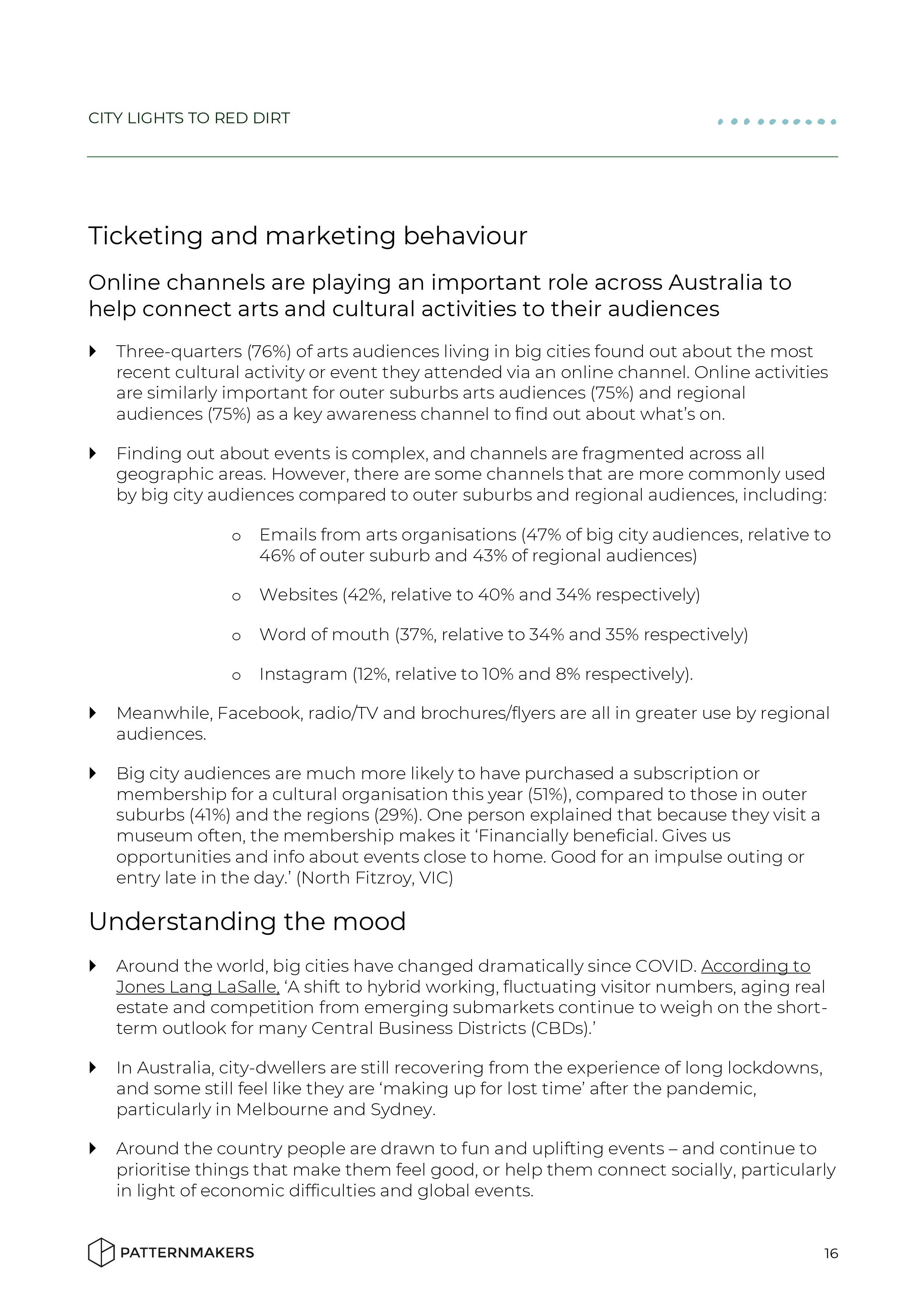


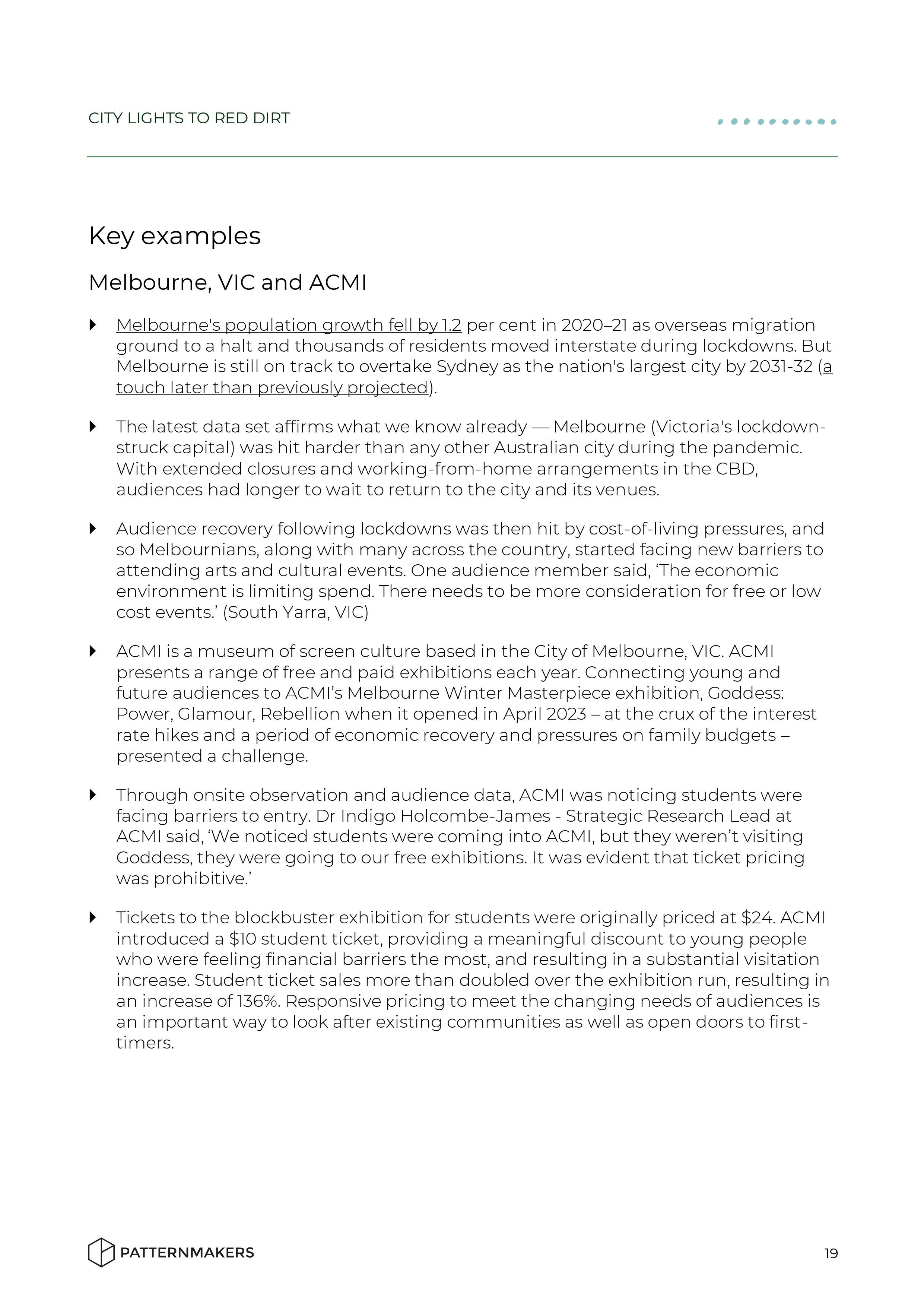





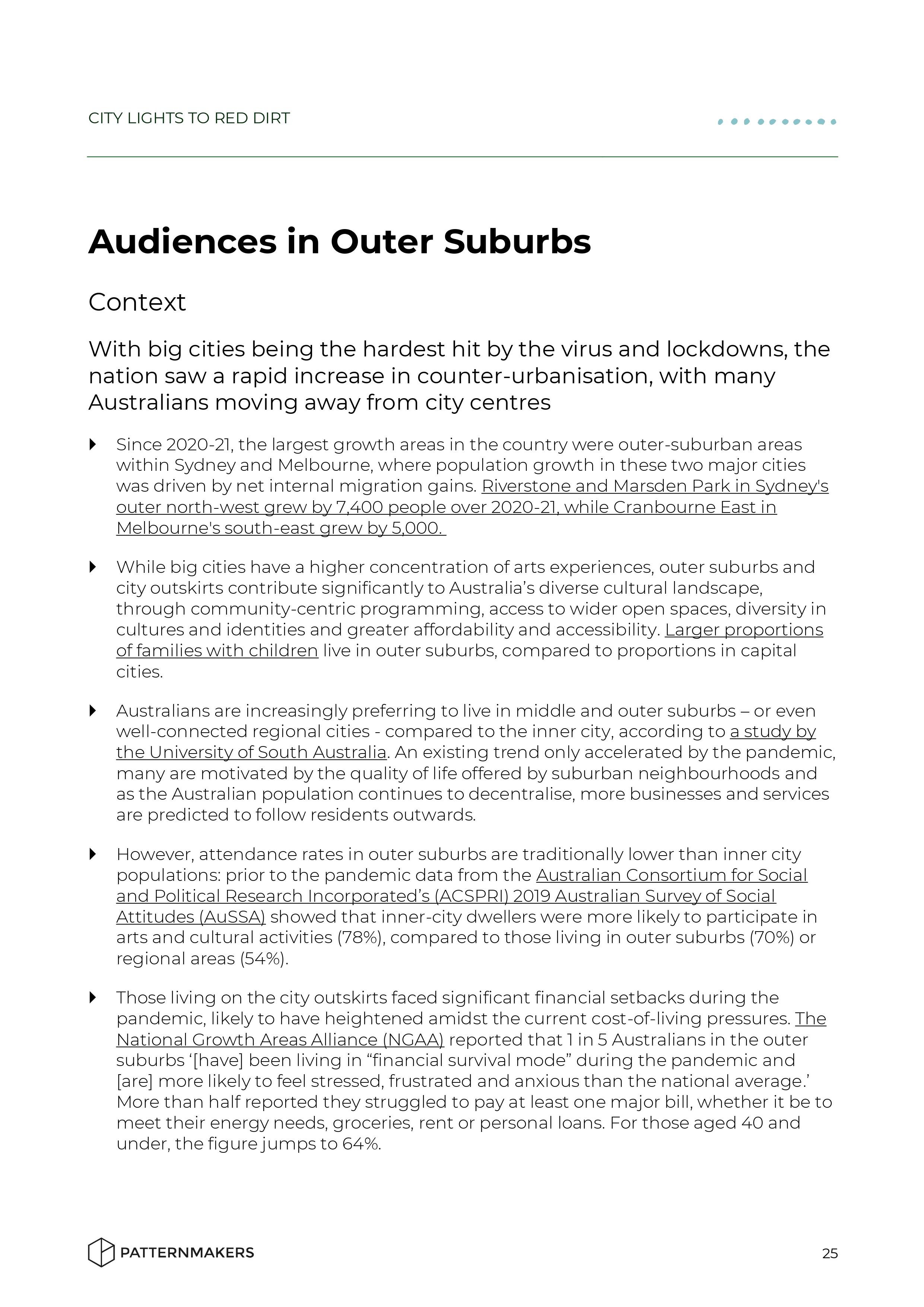



















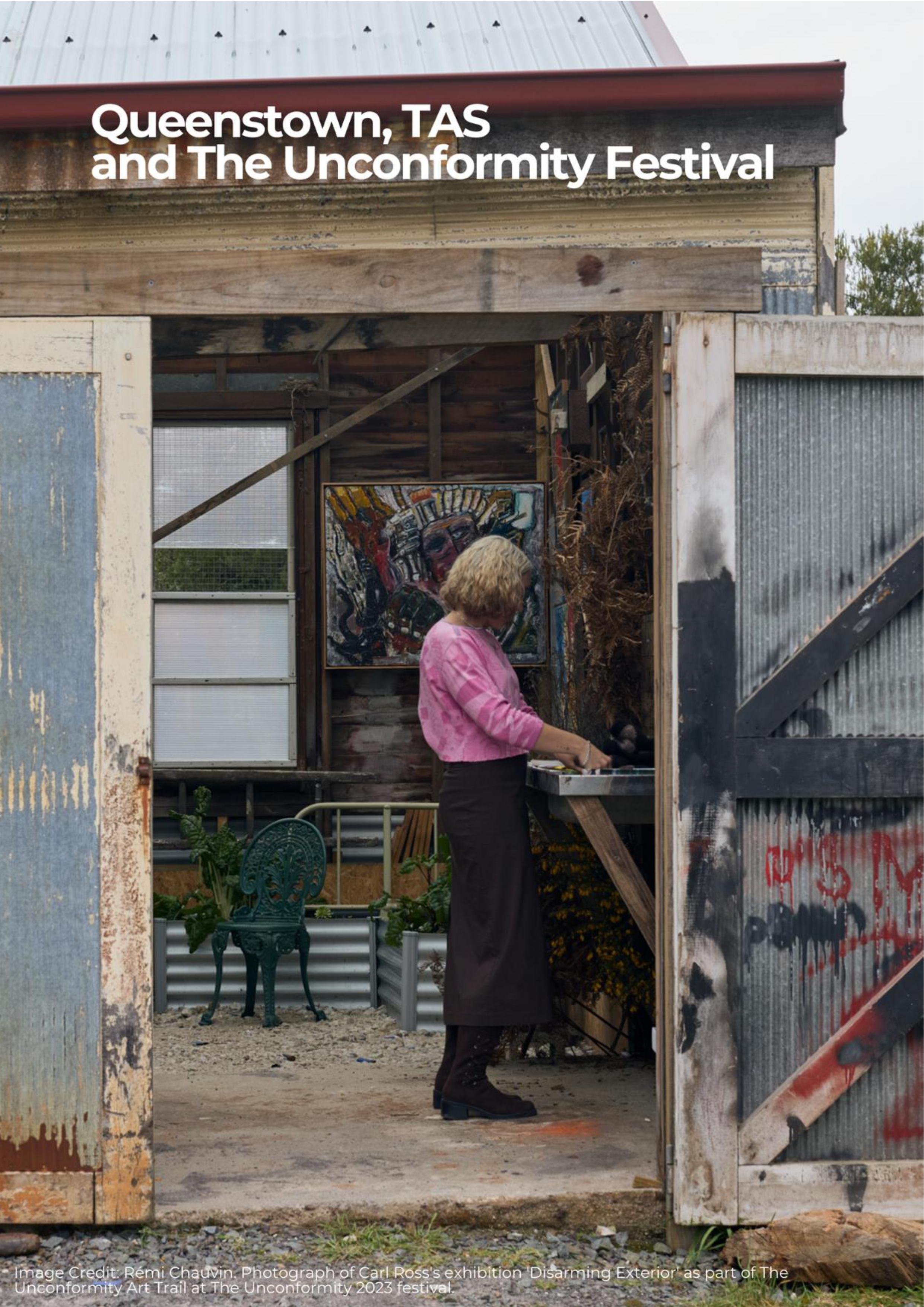
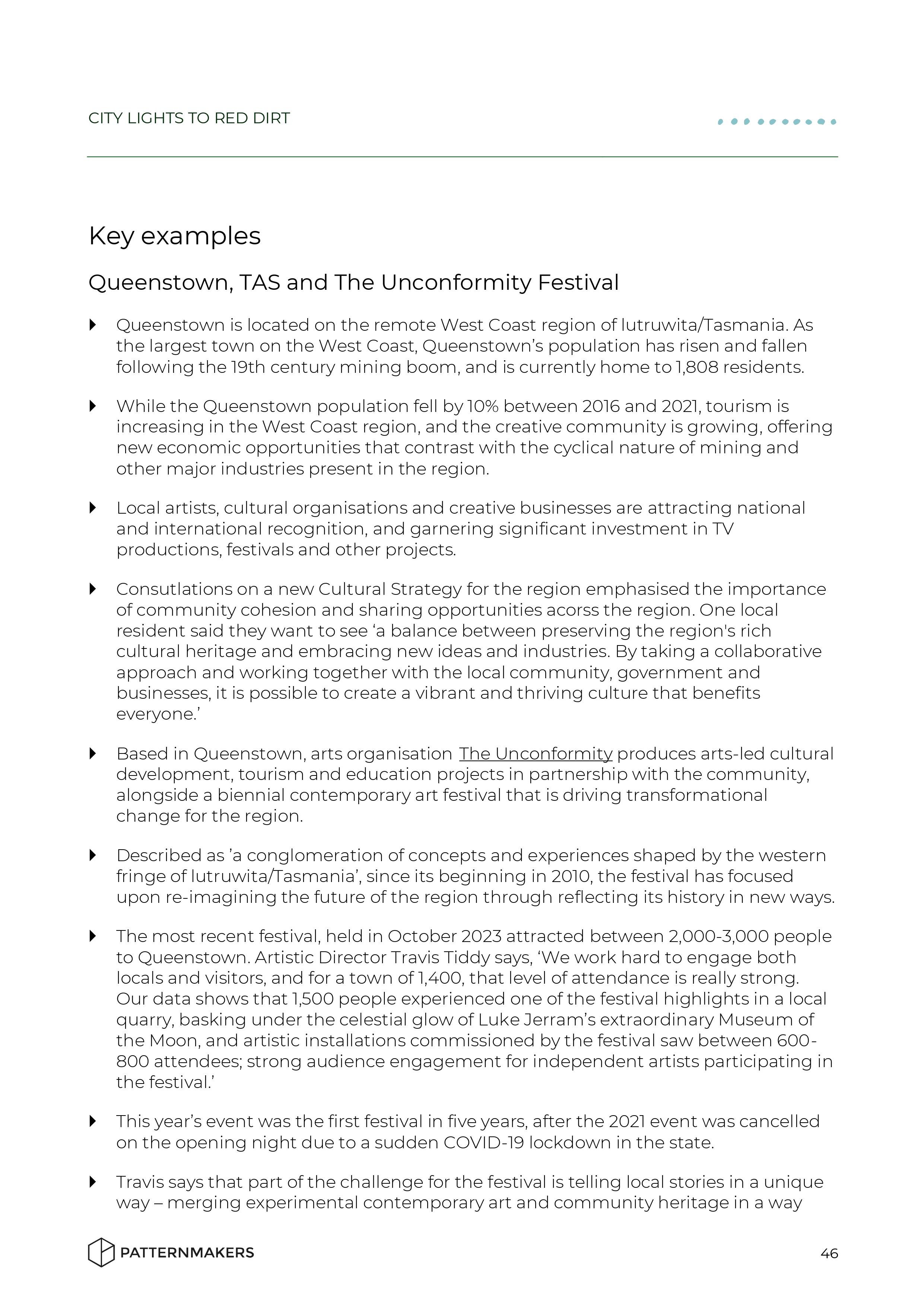








Click the buttons below to download the report, as a PDF or accessible Word version, or read on for more of the findings.
Three chapters, three geographic audience segments
The report compares audiences in three main geographic areas, providing insights for connecting people with culture where they live and the places they visit.
Download the chapters as separate fact sheets below.
Audiences in Big Cities
Arts audiences in big cities are experiencing the arts at high levels, but with market saturation and the shifting dynamics of Australia's CBDs post-pandemic, new challenges have emerged for organisations to cut through.
-
In Australia’s big cities, more people are attending arts events more often, but resident arts organisations are competing in a congested market. The data from past attendees shows that:
85% of big city audiences said they attended at least one kind of cultural event in the fortnight before data collection. Attendance is also more frequent amongst big city arts audiences: 38% attend a gallery or museum at least once a month, compared to outer suburbs (27%) and regional audiences (29%).
Arts audiences living in big cities are spending more on tickets to in-person live events and cultural activities: 7 in 10 spent more than $50 the fortnight before data collection (69%), compared to 65% of outer suburb audiences and 57% of regional audiences.
While most audiences are drawn to fun, uplifting and even escapist content right now, big city audiences are showing a greater appetite for challenging, topical content in the next 12 months (52%), compared to audiences living in outer suburbs and regional areas (both 41%). With more options on offer, they are also more likely to tune into reviews when considering what to attend.
Audiences in Outer Suburbs
Outer suburbs are the biggest growth areas in Australia right now, and have an expanding arts audience looking for more cultural experiences closer to home — but don't yet have enough venues nearby to accommodate.
-
In the outskirts and outer suburbs of big cities, the rate and frequency of attendance are slightly lower than big cities, but the market is growing, as more people move to more affordable areas where families can enjoy different lifestyles. The data from past attendees of events shows:
Audiences in outer suburbs are feeling slightly more pessimistic than optimistic about their financial situation, with almost half (46%) say they’re worse off than they were a year ago, and 25% expect to be financially worse off in the coming year.
Audiences in outer suburbs (combining both residents and visitors) were most likely to attend a cinema locally (59%), whereas big city audiences were comparatively more likely to attend a local live performance. Audiences in the regions were most likely to attend a fair/festival locally (40%) or visit a museum or gallery (51%).
Audiences in outer suburban areas are the least likely to be participating in online events right now. Half of outer suburbs residents say online arts events and experiences are playing a small (43%) or substantial role (8%) in their life, while another 49% say they play no role.
Audiences in the Regions
Across Australia's diverse regions, audiences are experiencing access to arts and culture differently. Factoring in extra time and travel costs means heightened barriers in 2023, but with a decentralising trend, more options could be on the cards.
-
Regional Australia is changing, with demographic shifts seeing some regional places grow dramatically in recent years – but rising costs of travel are leaving some isolated. There are different patterns for large towns, smaller villages and bush or outback areas, but on average, the data shows that:
Regional audiences indicated feeling less stable financially and more pessimistic about their future finances than those in outer suburbs and big cities, and many are being selective about what they attend right now. Almost half (47%) say they are ‘worse off’ financially than they were one year ago, and 26% expect to be ‘worse off’ in the coming year.
Regional audiences have lower levels of access to some types of events, like live performances, and therefore attend less often: 52% of audiences in the regions said they attend performing arts events at least once a month or more, lower than proportions in big cities (77%) and outer suburbs (63%).
Some art forms appear to reach audiences in regional areas better than others. For instance, in the past 12 months, 51% of regional audiences have attended contemporary music and 57% have attended libraries, which are similar to attendance rates in urban areas.
Four in ten regional audience members say that in the coming year, they’ll be most attracted to stories that are ‘about or from my local community’ (39%), slightly higher than the rate in big cities (32%) and outer suburbs (28%).
Get the data at a glance
Click the button below to download our Fast Facts for attendance, inflationary pressures, programming preferences and ticketing and marketing behaviour.
Read the ‘Audiences 2023+’ report
In case you missed it, click the button below for the key insights from the August 2023 National Snapshot.
Use the dashboard to get results for your artform and region
Survey data from Phase 9, which heard from over 8,800 respondents, has been uploaded to the dashboard, which now contains insights from over 100,000 Australian participants.
You can use the dashboard to explore the findings by state/territory, artform and audience segment.
It’s freely available to access, just click the image below and use the login details provided on the dashboard page.
About the Audience Outlook Monitor
The Audience Outlook Monitor provides the results of a study that has tracked audience sentiment over the course of the COVID-19 pandemic.
Data was collected in six phases throughout 2020-2022 and is again being tracked in 2023.
Government agencies across Australia are collaborating with research agencies Patternmakers (Sydney) and WolfBrown (USA) to produce this resource. The dashboard is freely accessible and designed to help artists and cultural organisations of all kinds to make the best possible decisions.
How to find out more
To receive new releases directly into your inbox, as soon as they are available, you can opt in to receive updates below.
If you have a question, or an idea for using this data, please contact Patternmakers at info@thepatternmakers.com.au
























































